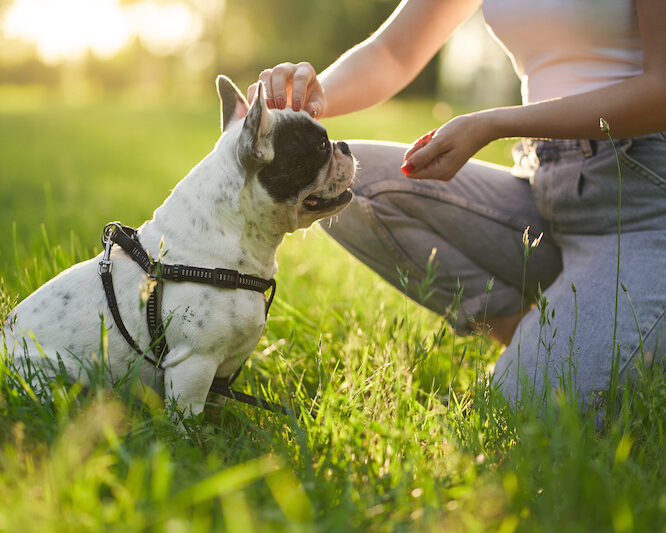One of the most common questions that pet training professionals get asked is how soon should you start training your pup should start with its training program. And the answer you will always get is ‘’As soon as possible!’’. Whether you’re working with a professional or training on your own, the program should begin the day you bring your new puppy home.
Puppies typically have a primary social development window that lasts until they reach the age of 9-14 weeks, so you should do your best to make interactions safe and fun during your puppy’s most formative weeks. If you feel like you don’t want to risk doing something that your puppy wouldn’t appreciate or like, then you should totally consider hiring a pet training professional to take care of your puppy training program for you.
Basic Things That You Can Do to Start Training Your Pup at Home
Here are five basic manners that you can initiate to start the training process for your new pup. You would need a lot of treats and toys to get your pup’s attention.
TEACHING YOUR PUPPY TO COME WHEN CALLED
- Sit with your puppy in a quiet place and either say their name or the word ‘’come’’.
- Give them a treat each time you do this.
- Drop a treat on the floor and as soon as your puppy finishes eating it, repeat their name and give them another treat when they look at you.
- Keep repeating this exercise until you start feeling comfortable with tossing the treat further away.
- Once the puppy starts turning around every time you either say their name or the word ‘’come’’, you should add some extra movements to the game (for instance, you could try and get your puppy to chase after you).
- When the puppy catches you, make sure to praise them along with giving some treats. Be sure to continue making these games even more fun by adding longer distances and other locations.
TEACHING YOUR PUPPY TO LOOSE-LEASH WALK
- Give your puppy some treats every time you want to put a leash on them.
- Take one step forward and give them the treat to encourage them to follow you.
- Continue giving them treats at the level of either your hip or your knee as you walk.
- If the puppy decides to run in front of you, turn in the opposite direction, tell them to come to you, and reward them right away.
- Be sure to let your puppy sniff and smell stuff every time you take them for a walk, and when they’ve had their sniffing time, say ‘’Let’s go!’’ in a happy voice and give the puppy a treat for listening to you.
TEACHING YOUR PUPPY TO SIT
Method A:
- Hold some of your puppy’s favorite dog food or treats in front of them.
- When they sit down, say ‘’yes’’ and give them a treat.
- Encourage the puppy to stand back up by taking a step back, then wait for them to sit down again.
- Give them another goody as soon as they sit.
- You can start saying the word ‘’sit’’ just when they are about to sit down.
Method B:
- Get down in front of your puppy with a treat in your hand.
- Put the treat in front of them, then use slow movements to lift it above their head.
- Don’t let the puppy eat the treat before they sit down.
- Start using your empty hand (continue rewarding the puppy every time they sit down, though).
- You can start saying the word ‘’sit’’ right before giving your puppy the hand signal.
TEACHING YOUR PUPPY TO LAY DOWN
Method A:
- Start by waiting for your puppy to lay down.
- Reinforce the puppy with a treat when they lie down.
- Give them the cue to stand back up, then wait for them to lie down again.
- You can slowly start saying the word ‘’down’’ right before they lie down on the floor.
Method B:
- Hold a treat in your hand and slowly bring it to the floor.
- Reward your puppy with the treat when their elbows touch the floor.
- Slowly start bringing your empty hand to the floor and only reward the puppy AFTER they lie down.
- You can start saying the word ‘’down’’ as you move your hand.
TEACHING YOUR PUPPY TO STAY
- Choose either ‘’OK’’ or ‘’free’’ as your release word.
- Toss a treat on the floor and say the word as your puppy steps forward.
- Keep doing this until you can say the word first and then toss the treat AFTER the puppy begins to move.
- Give your puppy a treat when they learn how to sit on cue.
- Give them another treat for staying in a sitting position.
- Start adding more distance.
- Continue practicing until you start feeling like your puppy is entirely ready.
Conclusion
Keeping each training session short and fun is an extremely important thing to do when it comes to training your new puppy. You should also do your best to end each training session on a positive note. Suppose you notice that your puppy is either stubborn or having difficulty learning new things. In that case, you should probably evaluate either the value of your rewards or the speed of your training sessions. You can also engage a professional dog trainer to help you with the process.
These tricks work most of the time and you can also use them to train your older dogs. With this in mind, if you and your dog continue to work hard, it’s pretty safe to say that the results will show before you and your four-legged friend even realize it!







